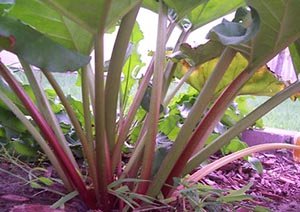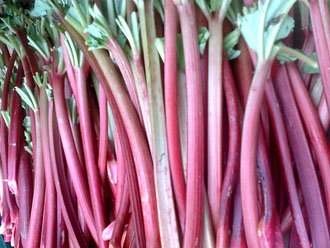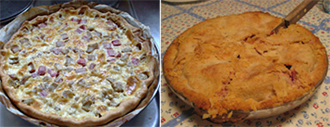Rhubarb Nutrition facts
Rhubarb is a perennial herb grown for its attractingly succulent, rose-red, edible leafy stalks. This cool-season plant is native to Siberia and widespread in many regions of Europe and North America as a “pie plant.” In its natural habitat, the plant expands over the ground surface as a large spread.
Botanically, it belongs to the family of Polygonaceae, in the genus: Rheum, and known as Rheum rhabarbarum.
 |
| Rheum rhabarbarum plant. Courtesy: Rochelle |
Rhubarb is one of the easy plants to grow and can last for many years (10-15 years) once established. It is usually propagated through implanting old rhizome (root) divisions. A completely grown plant features 12 to 18 inches long leaf-petiole, spreading into a broad, heart-shaped, dark green leaf. It is these stalks (petioles) that are being used (upon discarding their top-leaf part) for human consumption.
The petioles (stalks) can be ready for harvesting from the second year onwards when they reach a sufficient size of about one to two inches in thickness.
Several cultivars exist. Some of the traditional varieties grown inside the US are Canada-red, cherry red, Burgess-`Colossal’, MacDonald, ruby, valentine,…etc. Generally, red-stalk varieties are preferred since they tend to have more subtle, sweeter stalks.
Health benefits of Rhubarb
Rhubarb is one of the least-calorie vegetables. 100 g fresh petioles carry just 21 calories. Nonetheless, it holds some vital phytonutrients such as dietary fiber, polyphenolic antioxidants, minerals, and vitamins. Further, its petioles contain no saturated fats or cholesterol.
The stalks are good at several B-complex vitamins such as folates, riboflavin, niacin, vitamin B-6 (pyridoxine), thiamin, and pantothenic acid.
Red color stems carry more vitamin A than the green varieties. Further, the stalks also contain small amounts of polyphenolic flavonoid compounds like ß-carotene, zeaxanthin, and lutein. These compounds convert into vitamin A inside the human body and deliver the same protective effects as vitamin A.
Vitamin A is a powerful natural antioxidant that is required by the body for maintaining the integrity of skin and mucosa. It is also an essential vitamin for healthy eyesight. Research studies suggest that natural foods rich in this vitamin may help protect from lung and oral cavity cancers.
As in other greens like kale, spinach, etc., rhubarb stalks also provide proper amounts of vitamin-K. 100 g of fresh stalks provide 29.3 µg or about 24% of the daily recommended intake of this vitamin.
Vitamin-K has a potential role in bone health by promoting osteoblastic (bone formation and strengthening) activity. Adequate vitamin-K levels in the diet help limit neuronal damage in the brain; thus, has an established role in the treatment of Alzheimer's disease.
Its stalks also contain healthy levels of minerals like iron, copper, calcium, potassium, and phosphorus. However, most of these minerals do not absorb into the body as they undergo chelation into insoluble complexes by oxalic acid, which then, excreted out.
| Principle | Nutrient Value | Percent of RDA |
|---|---|---|
| Energy | 21 Kcal | 1% |
| Carbohydrates | 4.54 g | 3% |
| Protein | 0.90 g | 2% |
| Total Fat | 0.20 g | 1% |
| Cholesterol | 0 mg | 0% |
| Dietary Fiber | 1.8 g | 5% |
| Vitamins | ||
| Folates | 7 µg | 2% |
| Niacin | 0.300 mg | 2% |
| Pantothenic acid | 0.085 mg | 1.5% |
| Pyridoxine | 0.024 mg | 2% |
| Riboflavin | 0.030 mg | 2% |
| Thiamin | 0.020 mg | 2% |
| Vitamin A | 102 IU | 3.5% |
| Vitamin C | 8 mg | 13% |
| Vitamin E | 0.27 mg | 2% |
| Vitamin K | 29.3 µg | 24% |
| Electrolytes | ||
| Sodium | 4 mg | 0.5% |
| Potassium | 288 mg | 6% |
| Minerals | ||
| Calcium | 86 mg | 8.5% |
| Copper | 0.021 mg | 2% |
| Iron | 0.22 mg | 3% |
| Magnesium | 12 mg | 3% |
| Manganese | 0.196 mg | 8.5% |
| Phosphorus | 14 mg | 2% |
| Selenium | 1.1 µg | 2% |
| Zinc | 0.10 mg | 1% |
| Phyto-nutrients | ||
| Carotene-α | 0 µg | -- |
| Carotene-ß | 61 µg | -- |
| Crypto-xanthin-ß | 0 µg | -- |
| Lutein-zeaxanthin | 170 µg | -- |
Selection and storage
Fresh rhubarb stalks can be readily available in the markets from April until August. If you are growing them in the backyard, harvest its leaf petiole (stalk) by grabbing at its base, simultaneously pulling and twisting as you do it while snapping celery stalks. Immediately separate the petiole from its leaf part (leaf blade). Green tops of rhubarb contain oxalic acid as well as poisonous glycosides. Additionally, the top greens drain away nutrients from its stalk.
While buying from the markets look for fresh, firm, crispy bright-red color stalks. They usually put for sale in bunches along with other typical greens. Avoid those stalks that feature dull, slump or bruise or blemishes on the surface.
 |
| Fresh rhubarb stalks in a market. Photo: roland |
Once at home, harvested or purchased stalks should be placed in a plastic bag and stored in the refrigerator set at 32°F and 95 percent relative humidity. This way, stalks can stay fresh for about 2-3 weeks.
In the shops, one may also find ready-to-use, processed rhubarb preparations like canned, vacuum-packed, freeze-dried, etc.
Preparation and serving methods
Fresh rhubarb stalks feature a rich sweet-tart flavor. In general, rhubarb stalks of young crinkled leaf tops have no or few strings and have a sweet taste.
To prepare: Trim the ends using a paring knife. Wash them in cold running water, gently scrubbing the surface using your fingers. Cut stalks into 1/2-inch to 1-inch pieces using a paring knife. Usually, their extreme tartness is somewhat tamed by the addition of sugar, honey, and glucose syrups.
Here are some serving tips:
 |
| Rhubarb tart. Courtesy: lejoe, and pie! Courtesy: purpleslog |
Its crispy, juicy stalks can be used in the preparations of sauces, preserves, jellies, jams, syrups, sorbet, juice…etc.
Rhubarb is best remembered for its delicious pies.
It can also be used in the preparations of tarts, puddings, crumbs, pancakes, muffins, strudel,..etc.
Safety profile
Top greens of rhubarb should be avoided in the cooking. Its leaf (blade) contains unusually high amounts of oxalic acid, a naturally occurring substance found in some vegetables.
100 g of stalks contain about 0.59 - 0.72 mg of oxalates. The lowest published lethal dose (LDLo) of oxalate in humans is 600 mg/kg. Oxalate can cause severe toxic symptoms even at much lower concentrations than this on the human body. Symptoms may include burning of the eyes, mouth, and throat; skin edema, and difficulty breathing. In severe cases, it can result in kidney failure, convulsions, coma, and death. (Medical Disclaimer).
≺≺ Back to Vegetables from Rhubarb nutrition. Visit here for an impressive list of vegetables with complete illustrations of their nutrition facts and health benefits.
≺≺ Back to Home page.
Further Reading (Links open in new window)
University of Illinois extension.- Vegetable directory.
University of Kentucky-Specialty Crop Profile: Rhubarb.